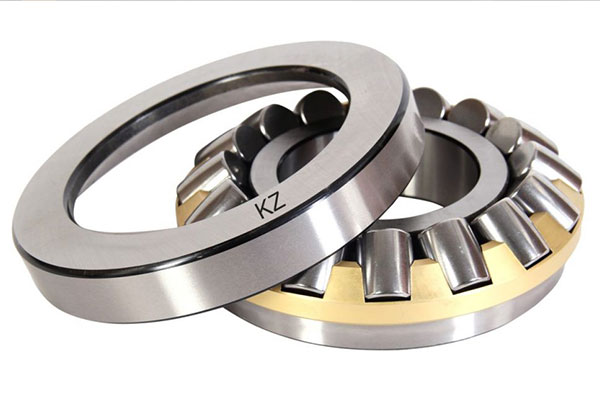The Spherical Roller Thrust Bearing
KZ spherical roller thrust bearing is a rolling-element bearing of the thrust type that allows rotation with less friction and permits angular misalignment. The bearing is designed to take the radial load and heavy axial load in one direction. Spherical roller thrust bearings have specially designed raceways and asymmetrical rollers.

CAGE DESIGNS: Machined Brass Cage (M), Pressed Steel Cage (E), EJ
Bearings can accommodate axial loads acting in one direction as well as radial loads acting in one direction. The load is transmitted through the rollers at an angle to the bearing axis between the raceways, while the flange guides the rollers.
Construction
Spherical roller thrust bearings comprise of a shaft washer (for radial bearings regularly called "inner ring"), a lodging washer (for radial bearings frequently called "outer ring"), asymmetrical rollers, and a cage. There are also bearing units available that can take axial loads in two directions.
d Bore diameter
D Outside diameter
H Nominal Height
d1 Outside diameter of shaft washer end side face
D1 Shoulder diameter outer ring
B Width shaft washer or length of shaft washer bore diameter that fits on the shaft (bearings with a stamped steel cage)
B1 Height shaft washer + cage
C Height housing washer
s Distance from shaft washer end side face to pressure point
r1,2 Chamfer dimension shaft washer

Materials
Bearing rings and rolling elements can be made of various materials, yet the most well-known is "chrome steel", a material with around 1.5% chrome content. Such "chrome steel" has been normalized by various specialists, and there are in this manner various comparable materials.
For example, AISI 52100 (USA), 100CR6 (Germany), SUJ2 (Japan), and GCR15 (China).
KZ SERIES: 29200,29300,29400
Some normal materials for bearing confines:
• Sheet steel (stamped or laser-cut)
• Brass (stamped or machined)
• Steel (machined)
The decision of material is basically done by the assembling volume and technique. For very large volume bearings, confines are regularly of stamped sheet metal, while low volume series frequently have enclosures of machined metal or machined steel.
Applications and Industry: CEMENT INDUSTRY, CRUSHER INDUSTRY, HEAVY MACHINERY EQUIPMENTS, MINING SECTOR, METAL INDUSTRY, FLUID MACHINERY, TEXTILE INDUSTRY

